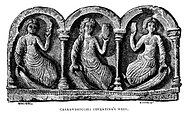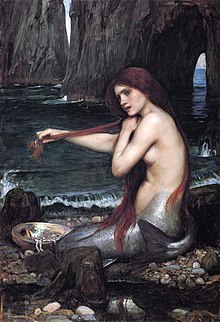Hebridean mythology and folklore
| Part of a series on |
| Celtic mythology |
|---|
 |
| Gaelic mythology |
| Brythonic mythology |
|
| Concepts |
| Religious vocations |
| Festivals |
|
The Inner and Outer Hebrides off the western coast of Scotland are made up of a great number of large and small islands. These isolated islands are the source of a number of Hebridean myths and legends. It is a part of Scotland which has always relied on the surrounding sea to sustain the small communities which have occupied parts of the islands for centuries, therefore, it is natural that these seas are a source for many of these legends.
Water spirits[]
Kelpies[]

Kelpies were said to occupy several lochs, including one at Leurbost.
Blue men[]
The blue men of the Minch (also known as storm kelpies), who occupy the stretch of water between Lewis and mainland Scotland, looking for sailors to drown and stricken boats to sink.
Seonaidh (Shonny)[]
Seonaidh – a water-spirit who had to be offered ale.
Merpeople[]

It has been claimed that there is a mermaid's grave in Benbecula, but the exact location is unknown. The mermaid was killed in the early nineteenth century after having been seen for a couple of days, before a teenage boy threw a rock at it, killing the entity. Accounts stated that the upper part of the creature was the size of an infant, while the bottom was like a salmon.
Water monsters[]
Loch monsters[]
Searrach Uisge – a monster who was said to occupy Loch Suainbhal. Resembling a capsized boat, this creature has been reported swimming around for one and a half centuries. Locals say lambs were once offered annually to the creature.[1] Other such creatures have been reported in several other lochs, including Loch Urubhal.
At Loch Duvat in Eriskay, while out looking for a horse that escaped his farm in the mist, a farmer saw what he thought was his missing beast in the loch. As he approached, he realised he was looking at a strange creature which gave an unearthly yell, sending the farmer running home.[1]
Sea monsters[]
Various sea monsters have been reported off the shores of Lewis over the years, including a sighting reported in 1882 by a German ship off the Butt of Lewis. The ship, 15 kilometres off the coast, reported a sea serpent around 40 metres in length, with several bumps protruding from the water, along its back. Sea serpents have also been reported at the southern side of the island.[1]
Werewolves[]

A family of werewolves were said to occupy an island on Loch Langavat. Although long deceased, they promised to rise if their graves were disturbed.[1]
Will-o'-the-wisp[]
Wills-o'-the-wisp have been reported in the area of Sandwick. The lights that float around the area normally announce approaching death for a local. Some say the light belongs to an Irish merchant who was robbed and murdered on the island.[1]
Sithchean (fairies)[]
In traditional Hebridean folklore, the Sithchean (or fairies) are a morally ambiguous supernatural race of small humanoid creatures that inhabit knolls and places of special significance across the Hebrides. Evidence of the Sithche are found throughout the Hebrides interwoven within its landscape, stories, music and traditional healing beliefs of the native Hebridean people. The Sithchean are thought to be the distorted folk memory of the Iron Age Pictish peoples who inhabited the Hebrides before they amalgamated into the Gaelic and Viking societies that became dominant after their end.
Appearance[]
Like regular men and women, the sithchean sexes differ both in appearance and characteristics. The Sithchean women are commonly noted as being no taller than a young girl in height, and wearing of green clothes. The Sithchean men are noted as being of four feet (or so) in height, and wearing clothes not exclusively (but most commonly) dyed red with "crotal" lichen. [2] [3] Most stories on the sithchean describe them as either great beauties or wizened creatures. The "Bean Shith" (Banshee) (literally Fairy woman) is noted as having no nostrils, webbed feet and long sagging breasts that cannot suckle her young. However this can be contradicted in other sources, and in them the Bean Shith is noted as being remarkably handsome. In Mull and the neighbouring islands, the Sithchean are said to have only one nostril; however this seems to be exclusive to this region of the Hebrides.
Dwelling[]
The Sithchen in stories are often seen from the entrance of their dwelling having a Ceilidh inside their knolls. Craig Hasten, a castle-like knoll to the south of the village of Baile Mòr in Paible, North Uist, is known locally as a dwelling place of fairies.[4]
Dogs[]
At Luskentyre in Harris, a hound has been known to leave oversized paw prints on the damp sand which vanish suddenly halfway across the beach. It is alleged that this is a fairy hound.[1] Then in South Uist, a woman walking with two friends in the pitch dark watched as a self-illuminating dog, the size of a collie but with a small head and no eyes, ran towards her. The creature vanished as it bounded past. On reaching home, she described what had happened to her aunt, the older woman told her it was a Cu Sìth, a fairy dog.
Gifts[]
One of the heirlooms of the chiefs of Clan MacLeod is the Fairy Flag. Numerous traditions state that the flag originated as a gift from the fairies.
Cows, said to have been found on the shores of Loscantire in Harris, Scorrybrec in Skye, and on the Island of Bernera, were called cro sith, `fairy cows´, simply because they were of no mortal breed, but of a kind believed to live under the sea on meillich, seaweed.
See also[]
References[]
- ^ Jump up to: a b c d e f Paranormal Database, Outer Hebrides Pages
- ^ Gregorson Campbell (1900), p. 38
- ^ Gregorson Campbell (1900), p. 10
- ^ "HEBRIDES: H8. Paible/Paibeil (Kilmuir, North Uist)". The Papar Project. Retrieved 30 December 2020.
- Scottish folklore
- Scottish mythology
- Isle of Lewis
- Celtic mythology